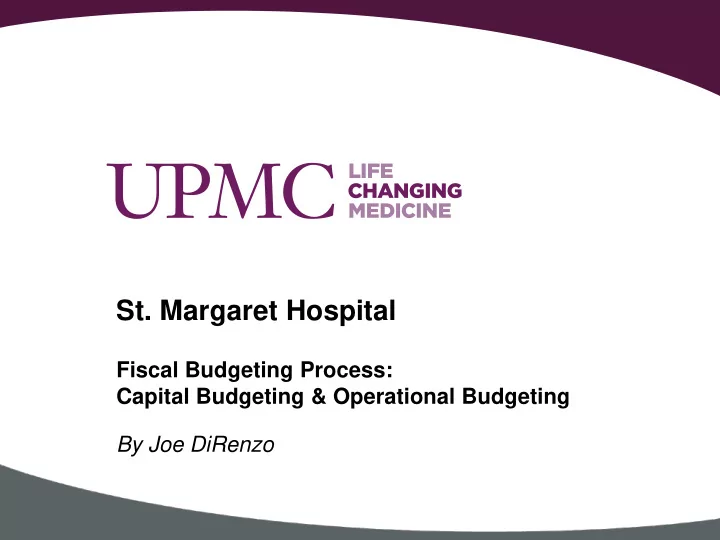

St. Margaret Hospital Fiscal Budgeting Process: Capital Budgeting & Operational Budgeting By Joe DiRenzo
Capital Budget Capital Categories & Requirements Routine Capital: Equipment (Medical & Non Medical) and Furniture. Routine Capital Requirements: Any new individual asset that has a life of two or more years and a cost that equals or exceeds $2,000 is capitalized. Any individual item with an acquisition of less than $2,000 is expensed. If similar items are purchased simultaneously (a group or bulk purchase), the decision to expense or capitalize is based on the unit cost of each item. ISD Capital: Capital items related to the Information Services Division or Information Technology (IT) related capital. Construction Capital: New construction and renovations. 2
Capital Budget UPMC Board Approved Capital Budget Routine Capital $ 62,200,000 Information Services $ 100,000,000 Construction $ 387,800,000 Investments in Joint Ventures $ 25,000,000 Total FY2012 $ 575,000,000 - FY2011 UPMC Operation Income was $406 million. - FY2012 Capital reinvestment budget is $575 million. - $28.5 million of the $62.2 million Routine Capital is allocated to the Hospital and Community Services Division. - $2 million of the $28.5 million if allocated to St. Margaret. 3
Capital Budget • Strata Jazz Capital Budgeting & Tracking System – Tracks year over year an inventory of Routine Capital items requested and purchased. – New items added to inventory annually during the budget process by departmental Directors & Managers. – System enables a hierarchy approval process through the VP level. – Finance, management and executive management categorize and rank every item to determine routine capital budget. – Throughout year, any non budgeted capital item purchased will need to be in place of a budgeted item. 4
Capital Budget • Strata Jazz Capital Budgeting & Tracking System – FY12 routine budget consists of about 40 items totaling $2 million. – Nearly 200 Items were requested totaling $9.6 million. • Fleet Equipment – Routine capital may be provided to a business unit outside its budget. – Fleet or bulk purchases of items used across the hospital division are made for items such as beds, monitors, imaging equipment, etc. – UPMC manages inventories that include condition and age of equipment across facilities to determine strategic fleet purchases. – Fleet purchasing allows UPMC’s economies of scale to leverage well negotiated contracts and pricing. 5
Capital Budget Capital Purchasing • Category codes for use when ordering Capital in eProcurement. Category Account Description Comments Account Code Description ASSET MANAGEMENT CLEARING Non Clinical related equipment > $2K per unit and useful Asset Management ASSET 144999 life >2 years. Clearing Clinical and research related equipment >$2K per unit and useful life >2 years When used in eProcurement the order Asset Management CLNEQ Clinical Medical Equip 144999 will flow to Biotronics first for approval and attachments Clearing and then to Corporate Assets for a Profile ID. 6
Operating Budget Operating Budget Components: • Volume • FTE’s • Expenses • Revenue 7
Operating Budget Volume • Inpatient volume is analyzed by Hospital Executive Financial Management to determine growth trends and market changes. – In recent years volume has been budgeted relatively flat, however in FY12, St. Margaret budgeted 1,100 incremental admissions for the West Penn Emergency Department closure. • Outpatient Volume is normally increased around 2% as we continually try to grow volume and make outpatient services more accessible. • Consideration added in for new programs (Physicians, Services, HBC Conversions, etc.) 8
Operating Budget FTE’s Productivity • Direct Hours: Volume vs. standard levels of care determines staff needed for direct patient care. • Indirect Hours: Various entries screens available which trend and are used to enter Indirect time such as PTO, Orientation and Meetings. Roster • Most recent pay periods roster is loaded, and productivity based FTE’s must tie to roster. Important to control & understand FTE growth (Volume, Patient Safety/Satisfaction, New Programs, etc). 9
Operating Budget Salaries (Over 50% of Controllable Expenses) • Calculated by each employee’s current rate x FTE compliment • Annual Merit increases are factored in. • Estimated or mid range rates plugged in for open positions. Benefits • FICA Benefit is 7.65% of Salaries. • Fringe Benefits 18.5% of Salaries. 10
Operating Budget Other Expenses • Supplies, Purchased Services and Other expenses are based from December YTD Run Rate annualized, then adjusted for incremental volume as well as inflation (normally 2.5%). Revenue • Complex modeling is performed by the UPMC Hospital Division Revenue Cycle Management Team. – Hospital payor mix, reimbursement rates and volume determine revenue. 11
Operating Budget Budget Spread • Volume is spread based on history. • The spread of the volume determines the allocation of variable FTE’s, Expenses and Revenues by period. – For example, a pay period for a nursing unit that has more budgeted patient days will also have more budgeted direct staff. • Fixed FTE’s, Expenses and Revenues may be spread by history or flat. 12
Budget in Summary • The budget process will continue to be a challenging but important process as hospital operations, the regional health care market and government regulations continue evolve. • UPMC System Leadership wants the budget to be accurate and understood, however is moving in the direction of shifting focus on running and understanding of daily operations. 13
Recommend
More recommend